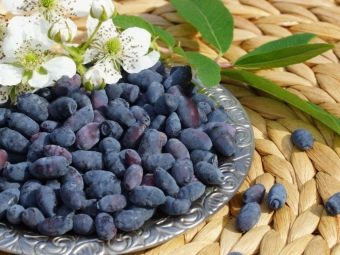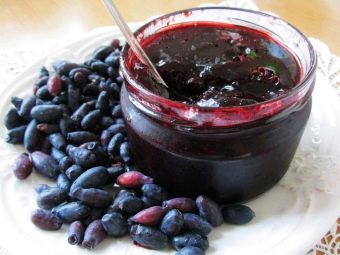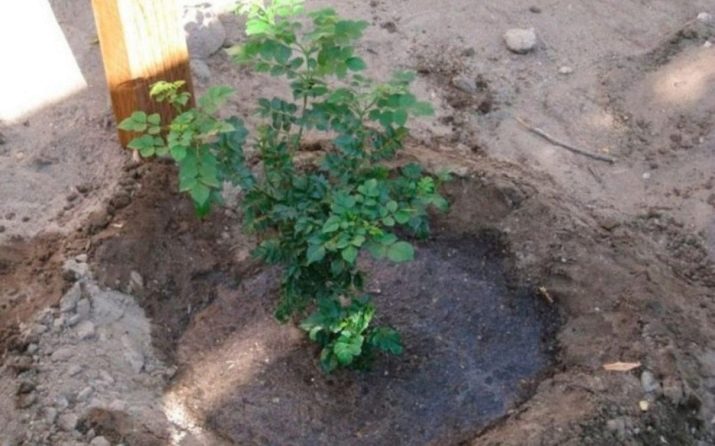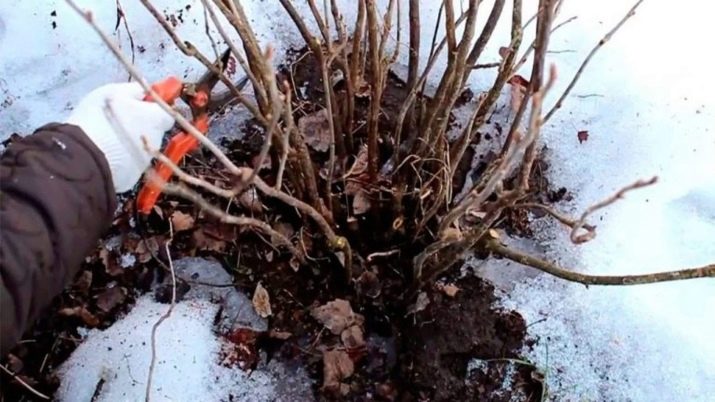Honeysuckle "Raisin": characteristics and technology of cultivation
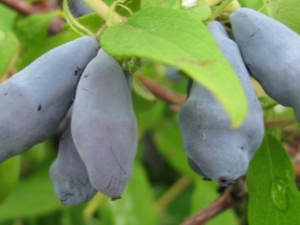
Honeysuckle is a truly amazing berry, it will be difficult to even simply describe all its useful and healing properties. That is why it is not surprising that more and more often this berry can be found in Russian gardens and kitchen gardens.Domestic scientists and breeders have not disregarded it, having withdrawn more than eighty honeysuckle varieties at the moment. In today's article we will discuss one of them, honeysuckle with the interesting name "Raisin".
Variety description
Honeysuckle "Raisin" began to appear in the gardens of domestic gardeners not so long ago, 10-15 years ago. It was bred by the South Ural Horticulture Research Institute as a seedling of Kamchatka honeysuckle from free pollination, and therefore it is in many ways similar to it. For example, like Kamchatka honeysuckle, the raisin variety tolerates cold well and is resistant to frost. It has characteristic large dark blue berries, weighing up to one gram and a low, but spreading crown.
However, unlike its predecessor, the Zest honeysuckle has a very low yield, only about a kilogram of berries from a bush. But compensates for this frequent and, importantly, stable yield.
The taste of berries is sweet and sour, with a dense, but soft skin. The pulp is slightly fibrous. In general, the berries are very tasty, so everyone will like jams and preserves of them. You can use honeysuckle and fresh, so it is even more useful.
The main feature of this variety is the low shedding of berries. But, as you know, this is the main problem faced by honeysuckle growers. Because of this, harvesting is complicated at times. But the owners of the variety "Zest" this problem is not terrible.
Features of planting and care
Like most berry bushes, honeysuckle is planted with seedlings, trying to grow it from seeds is an extremely time consuming and costly process. When buying a seedling, you should pay attention to the condition of its shoots, they should look healthy and without deformations.
Preference should be given to seedlings sold in pots or containers, but if you buy a seedling with open roots, then before planting it is better to soak them in a stimulating composition. Transportation "Zest" carries well, so you can easily order it from another city with delivery by mail.
Tips for planting honeysuckle:
- you should choose a place for planting honeysuckle in advance, a well-lit area on a hill would be best, as in darkened areas honeysuckle grows and bears very little fruit;
- honeysuckle does not like high humidity, and therefore you should not plant it in the lowlands near groundwater, otherwise you will need a good drainage system;
- honeysuckle extremely negatively transfers acidic soil, and therefore, if it is such in your area, then it will be useful to add ash or dolomite flour to the landing site;
- if the seedling has dry or damaged roots, it is recommended to trim them carefully right before planting;
- Honeysuckle should be planted in the fall in the pre-fertilized soil in the fall, it is recommended to fertilize the land with ash, humus and superphosphate;
- before planting, a shallow wide hole is dug up in the ground, about 40 by 40 centimeters;
- if several bushes are planted, then the distance between them should be not less than one and a half meters.
These simple tips will help you to grow on your site a healthy shrub with a good harvest. As for the care of the bush, here, too, everything is simple. The first years of its growth need only be watered with warm water and from time to time to mulch with needles, dry leaves or peat. Honeysuckle "Raisin" is considered moderately moisture-loving. In the first year the bush will not grow very quickly, this is due to the fact that at this time there is a development of the root system, you should not worry about this.
Three years after planting should begin to feed and trim your bush. The same humus (spring), ash (summer) and superphosphate (autumn) are used as fertilizers.
Gardeners already familiar with the cultivation of honeysuckle, do not recommend the use of mineral fertilizers, it is better to use organic matter.
Crop bush is in the autumn, in a period of rest.You should not neglect pruning, because another feature of the "Zest" variety is extremely rapid growth, as a result of which the bushes begin to look untidy and lose their yield.
After 6-7 years, the bush is subjected to rejuvenation. This can be done in two ways: full circumcision or gradual (2-3 branches each). At the same time, you can try to propagate the bush by cutting or dividing. "Raisin" has a unique resistance to frost and low temperature extremes. The variety does not need shelter even at the lowest temperatures. Sometimes at the beginning of spring, the upper parts of the shoots may freeze slightly, but you should not worry about this, they quickly grow.
With regard to protection against pests, as a preventive measure, it is recommended to use wood ash infusion and a solution of green soap, chemistry is not needed without special need.
It is better to process honeysuckle in summer, in no case should you do this in spring, as this is the period of ripening berries.
Honeysuckle variety "Zest" begins to bear fruit early, the berries ripen in the spring. Harvest can begin in May, and should be completed before the end of June. Perederzhivat berries undesirable, but otherwise you risk just losing the entire crop.
How to grow honeysuckle, you will learn from the following video.
Gardeners reviews
Variety "Zest" enjoys quite high popularity among Russian gardeners, and the reviews about it are generally positive. They note good frost resistance and the general stability of the shrubs, as well as the pleasant taste of berries. The disadvantages include low yield and rapid overgrowing of the bush. However, with proper care, the bushes look very presentable and are often even used to decorate the site.



